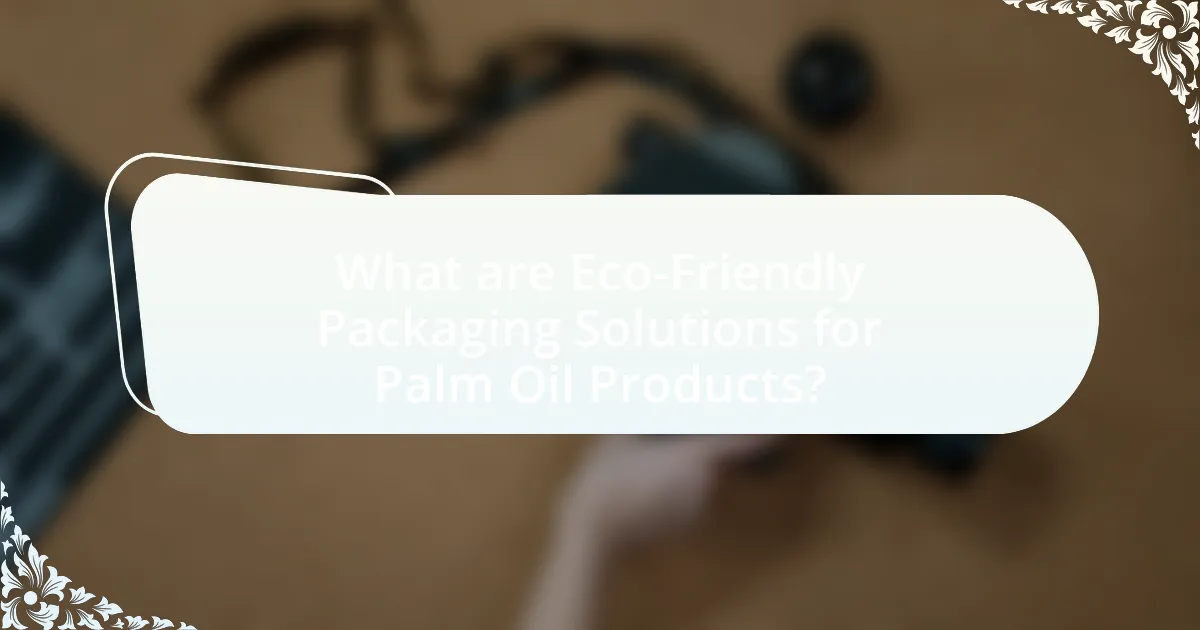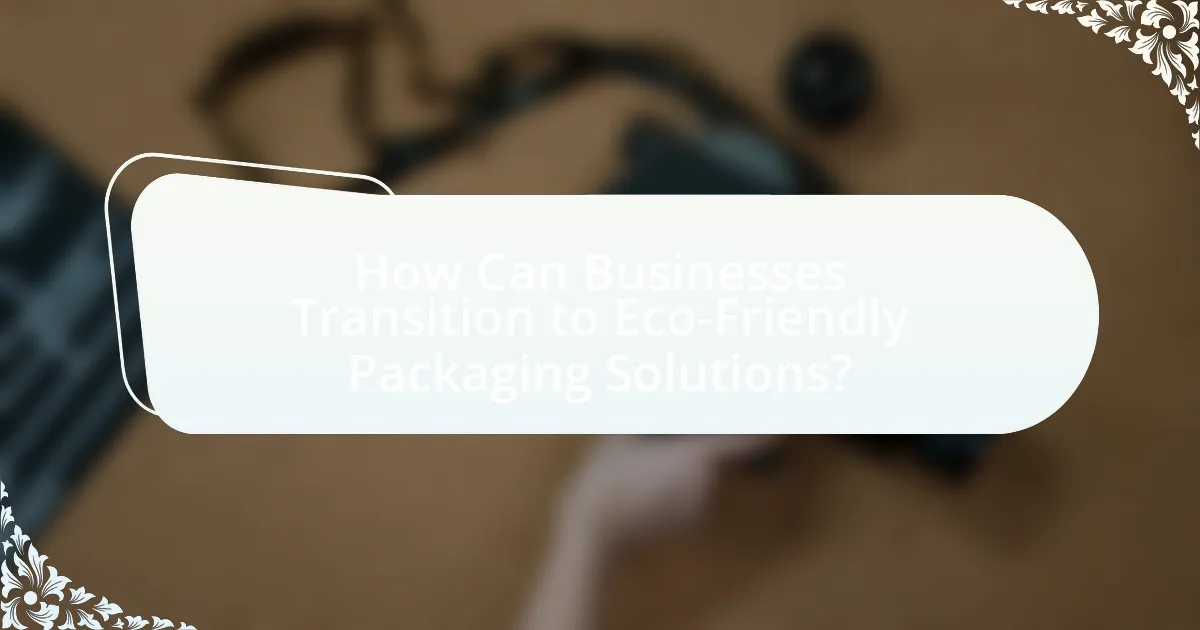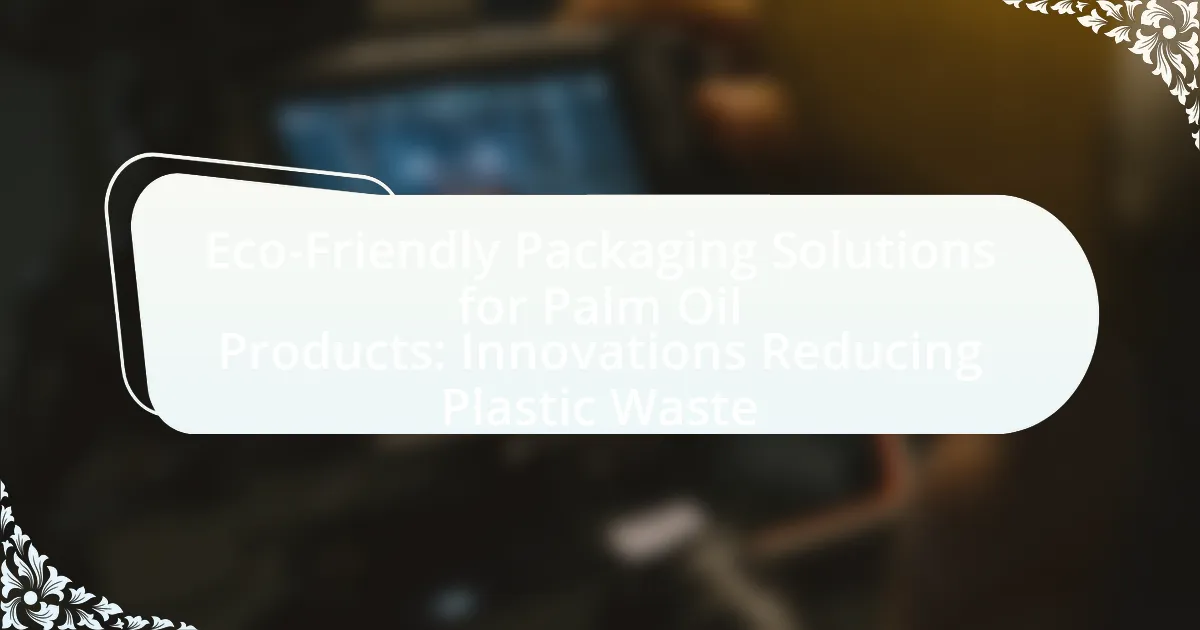Eco-friendly packaging solutions for palm oil products are essential in addressing environmental concerns associated with traditional packaging methods. This article explores various sustainable alternatives, including biodegradable materials, compostable films, and reusable containers, which significantly reduce plastic waste. It highlights the differences between eco-friendly and conventional packaging, the materials commonly used, and the innovations driving these solutions. Additionally, the article discusses the importance of eco-friendly packaging in promoting sustainability, the challenges faced in its implementation, and practical steps businesses can take to transition towards more sustainable practices.

What are Eco-Friendly Packaging Solutions for Palm Oil Products?
Eco-friendly packaging solutions for palm oil products include biodegradable materials, compostable films, and reusable containers. Biodegradable materials, such as plant-based plastics made from cornstarch or sugarcane, break down naturally in the environment, reducing plastic waste. Compostable films, which can decompose in industrial composting facilities, offer an alternative to traditional plastic packaging. Reusable containers, made from glass or metal, promote sustainability by minimizing single-use packaging. These solutions align with global efforts to reduce plastic pollution and support sustainable palm oil production practices.
How do these solutions differ from traditional packaging methods?
Eco-friendly packaging solutions for palm oil products differ from traditional packaging methods primarily in their materials and environmental impact. Traditional packaging often relies on single-use plastics that contribute significantly to pollution and waste, whereas eco-friendly alternatives utilize biodegradable, compostable, or recyclable materials that minimize environmental harm. For instance, innovations such as plant-based plastics or packaging made from agricultural waste not only reduce reliance on fossil fuels but also enhance the sustainability of the packaging lifecycle. Studies indicate that adopting these eco-friendly solutions can lead to a reduction in plastic waste by up to 70%, demonstrating their effectiveness in addressing environmental concerns associated with traditional packaging methods.
What materials are commonly used in eco-friendly packaging for palm oil?
Common materials used in eco-friendly packaging for palm oil include biodegradable plastics, recycled paper, and plant-based materials such as cornstarch and sugarcane. Biodegradable plastics, made from renewable resources, decompose more easily than traditional plastics, reducing environmental impact. Recycled paper is often utilized for its sustainability and ability to be repurposed, while plant-based materials provide a renewable alternative that minimizes reliance on fossil fuels. These materials collectively contribute to reducing plastic waste associated with palm oil packaging.
How do these materials contribute to reducing plastic waste?
Eco-friendly packaging materials contribute to reducing plastic waste by providing biodegradable or compostable alternatives to traditional plastic. These materials, such as plant-based bioplastics and recycled paper, break down naturally in the environment, minimizing long-term pollution. For instance, studies show that bioplastics can decompose within months under the right conditions, unlike conventional plastics that can take hundreds of years to degrade. By replacing single-use plastics with these sustainable options, the overall volume of plastic waste generated from palm oil products is significantly reduced, promoting a circular economy and lessening the environmental impact.
Why is eco-friendly packaging important for palm oil products?
Eco-friendly packaging is important for palm oil products because it minimizes environmental impact and reduces plastic waste. The palm oil industry is often linked to deforestation and habitat destruction, and using sustainable packaging helps mitigate these issues by promoting biodegradable or recyclable materials. According to a study published in the Journal of Cleaner Production, switching to eco-friendly packaging can significantly decrease the carbon footprint associated with product life cycles, thereby supporting environmental sustainability.
What environmental impacts are associated with conventional palm oil packaging?
Conventional palm oil packaging primarily contributes to environmental degradation through plastic pollution and deforestation. The use of single-use plastics in packaging leads to significant waste accumulation, with an estimated 8 million tons of plastic entering oceans annually, harming marine life and ecosystems. Additionally, the production of palm oil is often linked to deforestation, which results in habitat loss for endangered species and increased greenhouse gas emissions. Research indicates that palm oil cultivation is responsible for approximately 10% of global deforestation, exacerbating climate change and biodiversity loss.
How does eco-friendly packaging align with sustainability goals?
Eco-friendly packaging aligns with sustainability goals by reducing environmental impact through the use of biodegradable, recyclable, or compostable materials. This type of packaging minimizes plastic waste, which is a significant contributor to pollution and environmental degradation. For instance, a study by the Ellen MacArthur Foundation highlights that transitioning to sustainable packaging could reduce global plastic waste by 80% by 2040. Additionally, eco-friendly packaging often requires less energy and resources to produce, further supporting sustainability objectives by lowering carbon footprints and conserving natural resources.

What Innovations are Driving Eco-Friendly Packaging for Palm Oil?
Innovations driving eco-friendly packaging for palm oil include the development of biodegradable materials, plant-based plastics, and reusable packaging systems. Biodegradable materials, such as those derived from cornstarch or sugarcane, break down naturally, reducing environmental impact. Plant-based plastics, made from renewable resources, offer a sustainable alternative to traditional petroleum-based plastics, significantly lowering carbon footprints. Additionally, reusable packaging systems encourage consumers to return containers for refills, minimizing single-use waste. These innovations collectively contribute to reducing plastic waste associated with palm oil products, aligning with global sustainability goals.
How are companies innovating in the packaging sector for palm oil?
Companies are innovating in the packaging sector for palm oil by developing biodegradable and compostable materials that reduce plastic waste. For instance, some companies are utilizing plant-based polymers derived from renewable resources, such as cornstarch and sugarcane, to create packaging that decomposes naturally. Additionally, advancements in packaging design, such as using minimalistic approaches and refillable containers, are being implemented to decrease overall material usage. Research from the World Wildlife Fund indicates that these innovations can significantly lower the environmental impact associated with traditional palm oil packaging, which often relies heavily on single-use plastics.
What role does technology play in developing new packaging solutions?
Technology plays a crucial role in developing new packaging solutions by enabling the creation of innovative materials and processes that enhance sustainability. Advanced technologies such as biodegradable polymers, smart packaging, and 3D printing facilitate the design of eco-friendly packaging that reduces plastic waste. For instance, research indicates that the use of biodegradable materials can significantly decrease environmental impact, with studies showing that these materials can decompose within months compared to traditional plastics that take hundreds of years. Additionally, smart packaging technologies can improve supply chain efficiency and reduce waste by providing real-time data on product freshness and condition.
Which innovative designs are gaining popularity in the market?
Innovative designs gaining popularity in the market include biodegradable packaging made from plant-based materials and reusable containers specifically tailored for palm oil products. These designs are increasingly favored due to their ability to reduce plastic waste and environmental impact. For instance, a report by Smithers Pira indicates that the global market for biodegradable packaging is projected to reach $400 billion by 2025, reflecting a significant shift towards sustainable solutions. Additionally, companies like Eco-Products are leading the way by offering packaging solutions that are both functional and environmentally friendly, aligning with consumer demand for sustainable practices.
What are the challenges faced in implementing eco-friendly packaging?
The challenges faced in implementing eco-friendly packaging include higher costs, limited availability of sustainable materials, and consumer acceptance. Higher costs arise because eco-friendly materials often require more expensive production processes compared to conventional plastics. Limited availability of sustainable materials can hinder manufacturers’ ability to source suitable alternatives, as many eco-friendly options are not yet produced at scale. Additionally, consumer acceptance poses a challenge, as some consumers may be resistant to changing their purchasing habits or may not fully understand the benefits of eco-friendly packaging. These challenges are supported by industry reports indicating that while demand for sustainable packaging is growing, the transition remains slow due to these barriers.
How do cost factors influence the adoption of these solutions?
Cost factors significantly influence the adoption of eco-friendly packaging solutions for palm oil products by determining the financial feasibility for manufacturers. Higher initial costs associated with sustainable materials can deter companies from transitioning away from traditional plastic packaging, as they often prioritize short-term profitability. For instance, a study by the World Economic Forum indicates that while sustainable packaging can reduce long-term environmental costs, the upfront investment remains a critical barrier for many businesses. Additionally, fluctuating prices of eco-friendly materials compared to conventional plastics can impact decision-making, as companies seek to minimize expenses while meeting consumer demand for sustainability.
What regulatory hurdles must be overcome for eco-friendly packaging?
Eco-friendly packaging must overcome regulatory hurdles such as compliance with existing food safety standards, material approval processes, and environmental regulations. These regulations often require extensive testing to ensure that new materials do not leach harmful substances into food products and meet biodegradability or recyclability criteria. For instance, the U.S. Food and Drug Administration (FDA) mandates that any packaging material in contact with food must be safe and suitable for its intended use, which can delay the introduction of innovative eco-friendly solutions. Additionally, compliance with the European Union’s Packaging and Packaging Waste Directive necessitates that packaging materials meet specific environmental performance standards, further complicating the approval process for new eco-friendly packaging options.

How Can Businesses Transition to Eco-Friendly Packaging Solutions?
Businesses can transition to eco-friendly packaging solutions by adopting biodegradable materials, reducing plastic use, and implementing sustainable sourcing practices. For instance, companies can replace traditional plastic packaging with materials like plant-based bioplastics or recycled paper, which significantly lower environmental impact. Research indicates that the global biodegradable plastics market is projected to reach $6.9 billion by 2025, highlighting a growing trend towards sustainable alternatives. Additionally, businesses can collaborate with suppliers who prioritize eco-friendly materials, ensuring that their packaging aligns with sustainability goals. By integrating these practices, companies not only contribute to reducing plastic waste but also meet increasing consumer demand for environmentally responsible products.
What steps should companies take to adopt eco-friendly packaging?
Companies should conduct a comprehensive assessment of their current packaging materials and processes to adopt eco-friendly packaging. This involves evaluating the environmental impact of existing packaging, identifying sustainable alternatives such as biodegradable, compostable, or recyclable materials, and collaborating with suppliers who prioritize sustainability. Additionally, companies should invest in research and development to innovate packaging designs that minimize waste and enhance recyclability. Implementing a take-back program can further encourage recycling and reduce landfill contributions. According to a 2021 study by the Ellen MacArthur Foundation, transitioning to sustainable packaging can significantly reduce plastic waste, highlighting the importance of these steps in achieving environmental goals.
How can businesses assess their current packaging practices?
Businesses can assess their current packaging practices by conducting a comprehensive audit that evaluates materials, processes, and environmental impact. This audit should include analyzing the types of packaging materials used, their recyclability, and the carbon footprint associated with their production and disposal. For instance, a study by the Ellen MacArthur Foundation highlights that packaging accounts for over 40% of plastic waste, emphasizing the need for businesses to critically evaluate their packaging choices. Additionally, businesses can gather feedback from consumers regarding packaging preferences and sustainability concerns, which can inform improvements. By benchmarking against industry standards and regulations, companies can identify gaps and opportunities for adopting eco-friendly alternatives, ultimately reducing plastic waste in their packaging practices.
What resources are available for companies looking to make the switch?
Companies looking to make the switch to eco-friendly packaging solutions for palm oil products can access various resources, including industry guidelines, sustainability certifications, and supplier directories. The World Wildlife Fund (WWF) provides guidelines for sustainable palm oil sourcing, while organizations like the Forest Stewardship Council (FSC) offer certifications that validate eco-friendly packaging materials. Additionally, platforms such as Eco-Products and Sustainable Packaging Coalition provide directories of suppliers specializing in sustainable packaging options. These resources support companies in identifying suitable materials and practices that align with environmental goals, thereby reducing plastic waste effectively.
What best practices should be followed in eco-friendly packaging?
Best practices for eco-friendly packaging include using biodegradable materials, minimizing packaging size, and incorporating recycled content. Biodegradable materials, such as plant-based plastics or paper, break down naturally, reducing landfill waste. Minimizing packaging size not only conserves materials but also lowers transportation emissions; for instance, smaller packages require less fuel for shipping. Incorporating recycled content into packaging reduces the demand for virgin materials, thereby conserving resources and energy. According to a study by the Ellen MacArthur Foundation, transitioning to circular packaging systems can significantly reduce plastic waste and environmental impact.
How can companies effectively communicate their eco-friendly initiatives to consumers?
Companies can effectively communicate their eco-friendly initiatives to consumers by utilizing transparent messaging and engaging storytelling. Transparency involves clearly outlining the specific eco-friendly practices and materials used, such as biodegradable packaging or sustainable sourcing of palm oil, which can enhance consumer trust. Engaging storytelling can illustrate the positive environmental impact of these initiatives, making the information relatable and memorable. For instance, a study by Nielsen found that 66% of global consumers are willing to pay more for sustainable brands, indicating that effective communication can influence purchasing decisions. By combining clear information with compelling narratives, companies can foster a stronger connection with environmentally conscious consumers.
What metrics should businesses track to measure the success of their packaging transition?
Businesses should track metrics such as cost savings, customer satisfaction, waste reduction, and sales performance to measure the success of their packaging transition. Cost savings can be evaluated by comparing expenses before and after the transition to eco-friendly packaging, which often leads to reduced material costs and waste disposal fees. Customer satisfaction can be assessed through surveys and feedback, indicating how consumers perceive the new packaging in terms of sustainability and usability. Waste reduction metrics can be quantified by measuring the decrease in plastic waste generated from packaging, aligning with sustainability goals. Finally, sales performance should be monitored to determine if the transition positively impacts revenue, as consumers increasingly prefer environmentally friendly products. These metrics provide a comprehensive view of the effectiveness of the packaging transition.
What are some practical tips for implementing eco-friendly packaging solutions?
To implement eco-friendly packaging solutions, businesses should prioritize materials that are biodegradable, recyclable, or made from renewable resources. For instance, using plant-based plastics or recycled paper can significantly reduce environmental impact. According to a study by the Ellen MacArthur Foundation, transitioning to biodegradable packaging can decrease plastic waste by up to 80%. Additionally, companies can optimize packaging design to minimize material use while ensuring product protection, which not only conserves resources but also reduces shipping costs. Implementing a take-back program for used packaging encourages recycling and promotes a circular economy, further enhancing sustainability efforts.

Leave a Reply